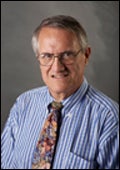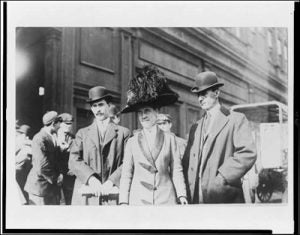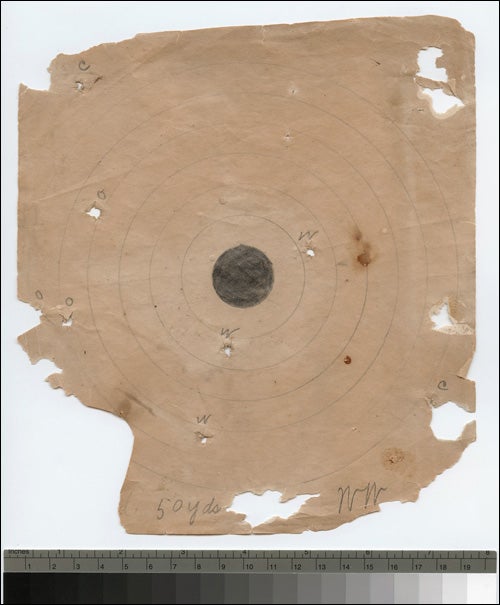More Wright Brothers artifacts verified at ECU
A set of shooting targets made and used by Orville and Wilbur Wright at their Kitty Hawk camp have been verified by an East Carolina University history professor and are on display at the university.
When the brothers were not testing their flying machines or hunkering down to wait out storms, Orville and Wilbur Wright used their 22-caliber Marlin repeating rifle for target practice. And they made bets as to who was the better shot, according to Dr. Larry E. Tise, Orville and Wilbur Wright Distinguished Professor of History at ECU.
The brothers also shot at birds, pigs and even mice in their camp home, Tise said. Letters, photographs and now the fragile, hole-filled targets initialed and signed by Orville and Wilbur Wright prove that they knew how to work their weapons, Tise said.
The targets will be on display in Joyner Library beginning Sept. 14 as part of a recently installed exhibit by Tise and several of his students, “The Wright Brothers Discovered Soaring Flight in 1911.” The artifacts will also be on display Sept. 13 in the lobby of Wright Auditorium as part of the Voyages of Discovery lecture, “Sky as Frontier: America’s Air and Space Century,” by Dr. David T. Courtwright, professor of history at the University of North Florida.
Tise’s announcement of the verification of these targets, found in a real estate office on the Outer Banks, coincides with the university’s commemoration of the centennial of the Wright Brothers’ last trip to Kitty Hawk in 1911 to conduct flying experiments.
Orville and his brother Lorin Wright returned to Kitty Hawk that year to test Orville’s theories on “soaring flight,” which is non-powered flight. On Oct. 24, 1911 Orville soared for 9 minutes, 45 seconds in Kitty Hawk, a record that held for almost 10 years. “You fly without an engine, but it’s not a glider,” Tise explained. “It’s based on thermals, or up drafts of warm air from the Earth’s surface.”
Tise said virtually no one knows that the Wright brothers always packed a gun when they went to Kitty Hawk and used it regularly while they were there.
“From their first visits to Kitty Hawk in 1900 until the last in 1911, Wilbur and Orville Wright always had a handy rifle with them, and they put it to very good use,” Tise said. Even as they made their first tentative glider flights in 1900, the brothers recorded that they went out hunting, Tise found in his research.
Tise had known for years that the normally quiet and mainly pacific brothers had kept a rifle with them at Kitty Hawk and that they had used it both for hunting and target shooting. At the outset of their first North Carolina expedition, Orville wrote, “we have succeeded in killing two large fish hawks each measuring over five feet from tip to tip.”
When he published in 2005 a book of photographs made by the Wright Brothers in North Carolina, Tise included a family snapshot of Orville cleaning the brothers’ Marlin rifle while at Kitty Hawk in 1911.

Tise
Tise first saw the targets in 2009 in the real estate office of Douglas Twiddy in Corolla. It wasn’t the first time that Tise had found a Wright Brothers artifact close to their original Kitty Hawk campsite. In 2007, Tise working with graduate students and others at ECU authenticated the original kitchen table from the Wright Brothers’ 1902 camp, now owned by an Outer Banks jeweler.
Unlike the table, which had no written documentation, the targets bear the initials and signatures of the brothers in their easily recognizable handwriting, Tise said. And in 1937 Orville Wright wrote a letter to an Outer Banks woman, Margaret Hallowell, confirming their authenticity. According to that letter the targets were made at Kitty Hawk in May 1908 for a set of shooting contests between the brothers and their mechanic Charles Furnas, who had accompanied them from Dayton flights that year.
Between preparations for their world renowned powered flights that year, the three young men relaxed by competing with each other to see who was the best shot, Tise said.
Tise turned his research to the woman who signed her letters, Miss Margaret Hallowell, to piece together how she came to possess the shooting targets. Tise found bits of the answer in her letters stored at different locations – the Library of Congress and with Hallowell’s descendants in N.C. and Georgia. When the Wright Brothers left their sheds to return to Dayton, summer residents in Nags head from towns like Edenton and Elizabeth City took it upon themselves to investigate what the brothers had left behind, Tise said.
In several of her letters, Hallowell acknowledged that after Wrights left Kitty Hawk in 1908 and became instant international stars that she and her brothers were curious to see what they could find in the brothers’ combination hangar, workshop, and dormitory. Tise said. “They broke into the shed and literally took everything of value—airplane parts, furnishings, china, rugs—everything,” he said.
During one of these raids Hallowell found the tiny targets scattered on the ground and decided that it would be her job to protect them for posterity. And this she did until her death. When her family eventually sold their home known as “Bayside” near Elizabeth City, the targets along with Orville’s confirming letter of 1937 were sold at an estate sale, Tise said. Twiddy purchased the targets for his real estate office at that sale.

Orville and William Wright are pictured with sister Katharine Wright (The Library of Congress image)
To authenticate the targets and Wright Brothers’ shooting habits on the Outer Banks, Tise turned to the Wright Brothers’ collection at the Library of Congress.
Among the stories he found was the following: In 1902 Wilbur wrote that Orville had successfully shot three “sea chickens,” each large enough to make up one bite of meat per brother for dinner. “After a bullet has gone through one of them, there is just a little meat left around the edges,” he wrote. But this was pretty expensive fare for their meals, he told their sister Katherine: “Our meat you see is costing us about 60 cts per pound in cartridges—so you understand what epicures we are in our eating.”
Aside from their birds of prey and their target practice, the most unusual hunting pursued by the brothers also occurred in 1902 when Orville decided to use their rifle to extinguish a pesky mouse, Tise said. After trying a variety of methods of ridding their wooden shed of mice, Orville awoke one morning to find a mouse standing on his chest, looking him in the eye.
The brothers leaped into action: Wilbur with a broomstick and Orville with the rifle. When the frightened mouse huddled in a corner to escape the fury, Orville reported that he “blazed away at him with the gun.” Unfortunately, he missed his prey and wrote: “The mark of the bullet is in the corner right back of where he stood, and I in my astonishment just stood there and watched him go.”
In 1908 and 1911, however, the brothers took up target practice very seriously, Tise said. Although the surviving targets prove that the brothers conducted target practice in 1908, neither brother mentioned the shooting episodes in their extensive diaries or letters from that year. Nor were they mentioned in 1911. However, a New York World reporter, Van Ness Harwood, who both reported upon and photographed the Wrights’ 1911 experiments, described their pauses from flying to do some target practicing.
Tise also took the targets to a pair of licensed forensic firearms and tool mark examiners for further analysis. “Between the targets and the photograph of Orville cleaning his rifle, the examiners concluded that the brothers were most-likely using a 22-caliber Marlin repeating rifle, that they were firing at the tiny 7-inch square targets from a distance of 50 yards, and that the brothers were standing while shooting without the benefit of gun rests,” Tise said.
The competition was that the person who came closest to the center of the bull’s eye with any single shot was the winner of that day’s competition. The initials beside the bullet holes—W, O, or C—indicated who had made that shot. And the initials at the bottom of each target—WW, OW, or Chas—indicated who had won that competition.
“Based on the four targets, Orville was evidently the best shot since he won two of the four competitions,” Tise said.
# # #
